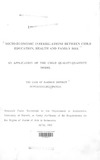| dc.description.abstract | The main objective of this study is to identify the
nature of the relationship between the quality and quantity
of children in the 8aringo district of Kenya. The analytical
framework was the child quality-quantity model based on
the consumer theoretical framework. Utilizing a static
cross-sectional simultaneous model the relative magnitude
and statistical significance of the influence of specific
economic variables on this two aspects of children were
estimated.
The main variables which were considered are :
opportunity cost of time (measured by parental wages
proxed by the number of years completed in school since
labour market is undeveloped in the rural areas), assets (in
this case land), market determined income, parental ages
(as control exogenous variables) and the availability of
facilities for health (proxed by an index of mortality) and
education.
Three main hypotheses are tested:
(i) the quality and quantity of children are inversely
related.
Multiple regression technique was used to analyze the
cross-sectional primary data which was collected mainly
from rural .Q6ringo district. The sample included 357
household covering all the divisions in the district.
(ii)· the level of child quality varies directly with the
VI
availability of educational and health utilizable facilities .
.The degree of utilization is determined by the level of
'- . parental education which is a measure of the cost of
information and the opportunity cost of rearing children.
(iii) the level of the quantity of children varies directly
with the ownership of assets, parental age plus poor
service environment and inversely with the parental
education, income, area of residence (urban or rural), use of
birth control devices and household size.
Quantity and quality of children are directly related
implying that the area under study is still in the first
stage of socio-economic development and therefore children
are a 'normal good'.
Empirical evidence indicate that the quality of
children is positively influenced by parental education,
income, developed service environment, size of family,
modern items owned and negatively by size of households,
area of residence.
On the other hand quantity of children is influenced
positively by acres of land owned, parental age, developed
service environment, area of residence, size of household,
father's education and inversely by mother's education,
income, utilization of birth control devices. Two policy recommendations that emerge from the
findings of the study are that:
(i) to increase the quality of children there IS a need to
improve the educational and health facilities.
(ii) to decrease sizes of families, policies to reduce
desired family sizes should be introduced and the methods
for birth control be made readily available. | en |

